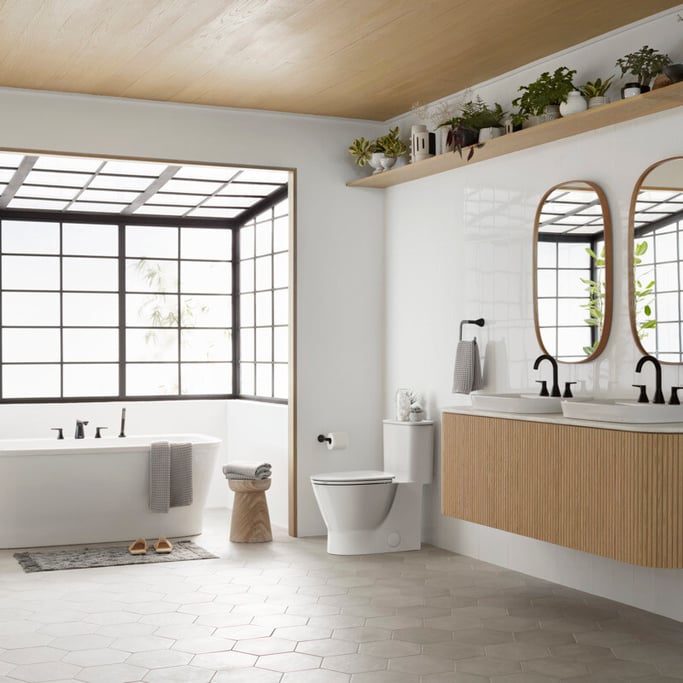Universal Living in the Americas - Multigenerational Housing

There's a strong emphasis on personal autonomy in the U.S., where success is often seen as moving out and establishing one's own household. However, in Europe, where I come from, we value the support, wisdom, and shared responsibilities that multigenerational living brings to family life. My own children had the privilege of growing up surrounded by not only siblings and parents, but also their grandparents, sharing traditions, music, cooking (lots of cooking!) and fostering deep family connections while my in-laws were still around. More and more, a number of factors drive families in the U.S to recognize the benefits of living together across generations. From my personal experience, this can bring many benefits.
Over the last 50 years, the number of people living in multigenerational households has continued to grow, presenting builders with opportunities to lead in livability, wellness, inclusivity, and innovation. More than 1 in 4 Americans currently live in multigenerational homes—and this trend is here to stay. Of those residents, more than 7 in 10 plan to continue living in a multigenerational home long term.
With this shift comes a change in how we design living spaces that cater to diverse family needs. With an almost 18 percent increase between 2010 and 2020 – creating these flexible, adaptable living spaces that are accessible and functional for everyone, regardless of age or ability, has become more important than ever. Using these universal principles, we can design homes that allow older adults to live independently for longer, reducing the need for assisted living facilities. We can help the younger generation save money in the face of rising housing prices. LIXIL is committed to making better homes a reality for everyone, everywhere – and the evolving American family is no exception.
However, embracing multigenerational living brings a level of complexity that architects, builders and designers must carefully navigate. Successfully blending these diverse needs requires a thoughtful and inclusive approach, ensuring that every member of the household feels comfortable and accommodated. Each generation within a household often has distinct priorities and preferences when it comes to designing adaptable living spaces, which can sometimes be in direct conflict with one another. To resolve these conflicts, it is essential to foster open communication and collaboration among all family members, ensuring that everyone's needs and preferences are considered and balanced in the final design. By addressing these challenges, architects, designers, and builders can create harmonious living spaces that celebrate the benefits of a multigenerational family structure.
As part of our commitment to being inclusive for all, LIXIL offers products with an array of designs and textures to meet the diverse needs and preferences of multigenerational households. The meticulously crafted Aspirations Collection from American Standard caters to the needs of families with young children, while its ADA Compliant line not only enhances a home's longevity but also prioritizes accessible technology, empowering individuals of all abilities to age gracefully and securely in their own space. As family dynamics or homeowners change, the fundamental building concepts of the home have the flexibility to evolve with its inhabitants for years to come.

Some designers may choose to overlook this trend, believing that families will return to living independently once the economy improves. However, the rise and staying power of multigenerational homes are closely tied to the evolving demographics of the U.S. population. The likelihood of living in a multigenerational home varies significantly by age, race, and geographic location. Families also cite many benefits of living together, including:
- Enhanced bonds or relationships among family members (79%)
- Making it easier to provide for the care needs of one or more family members (79%)
- Improved finances for at least one family member (76%)
- Positive impacts on personal mental and/or physical health (76%)
- Making it possible for at least one family member to continue school or enroll in job training (71%)
We must respond to this growing demand by crafting homes that seamlessly accommodate multiple generations while remaining attuned to community needs through strategic partnerships with vendors and manufacturers offering tailored products. Embracing universal design principles allows us to play a pivotal role in creating residences that not only address current needs but also anticipate and adapt to future requirements, ensuring better homes for generations to come.
Personally, having experienced the warmth and support of a close-knit family, I am passionate about promoting designs that foster these enriching family dynamics. And by creating homes that bring generations together, we build stronger, more connected communities.
 Written by Jean-Jacques L’Henaff, Leader, LIXIL Global Design, Americas
Written by Jean-Jacques L’Henaff, Leader, LIXIL Global Design, Americas
In this role, L'Hénaff identifies deep connections between product, brand, users and stakeholders to create lasting value. L'Hénaff joined LIXIL in 2013. During his tenure, he built an award-winning team, responsible for designing all American Standard and DXV products, branded environments (corporate headquarter, showroom, trades show exhibit), and, more recently, the new American Standard brand identity.



